Assignment on Multiple Intelligence Theory of Learning
VerifiedAdded on 2022/09/23
|5
|1308
|20
Homework Assignment
AI Summary
This assignment explores Howard Gardner's Multiple Intelligence Theory, which posits that individuals possess different types of intelligence, impacting their learning styles. The assignment discusses the theory's application in education, advocating for diverse teaching methods, curriculum design, and student assessments to cater to individual learning needs. It also examines the theory's relevance in clinical settings, suggesting that medical educators should adapt their teaching approaches to accommodate varied learning styles of students. The assignment highlights the importance of recognizing and leveraging different intelligences to enhance learning outcomes in both educational and clinical environments, leading to improved student engagement and practical knowledge. Key concepts include lesson design, interdisciplinary units, student assessments, and apprenticeships in the context of applying the theory to teaching methodologies.
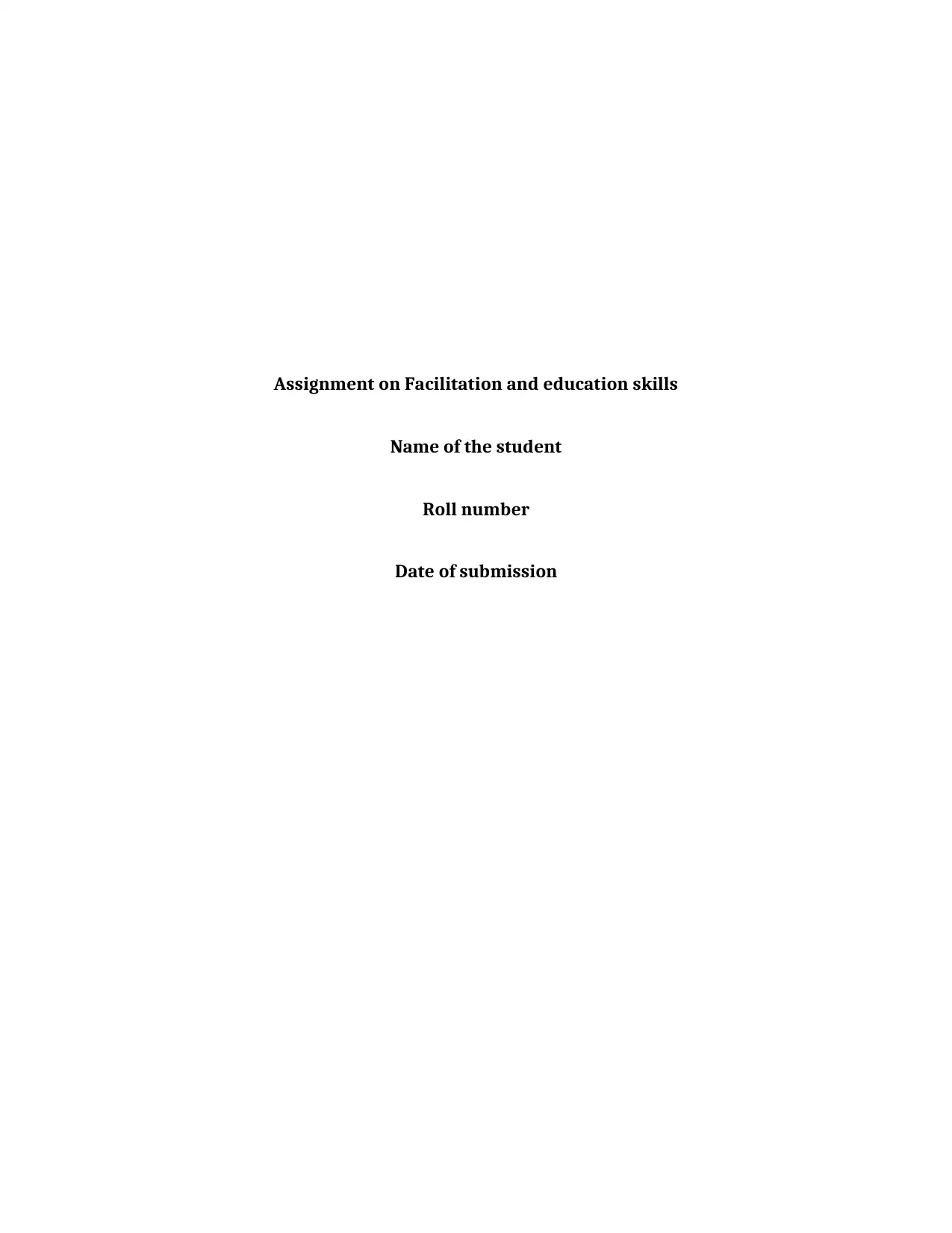
Assignment on Facilitation and education skills
Name of the student
Roll number
Date of submission
Name of the student
Roll number
Date of submission
Paraphrase This Document
Need a fresh take? Get an instant paraphrase of this document with our AI Paraphraser
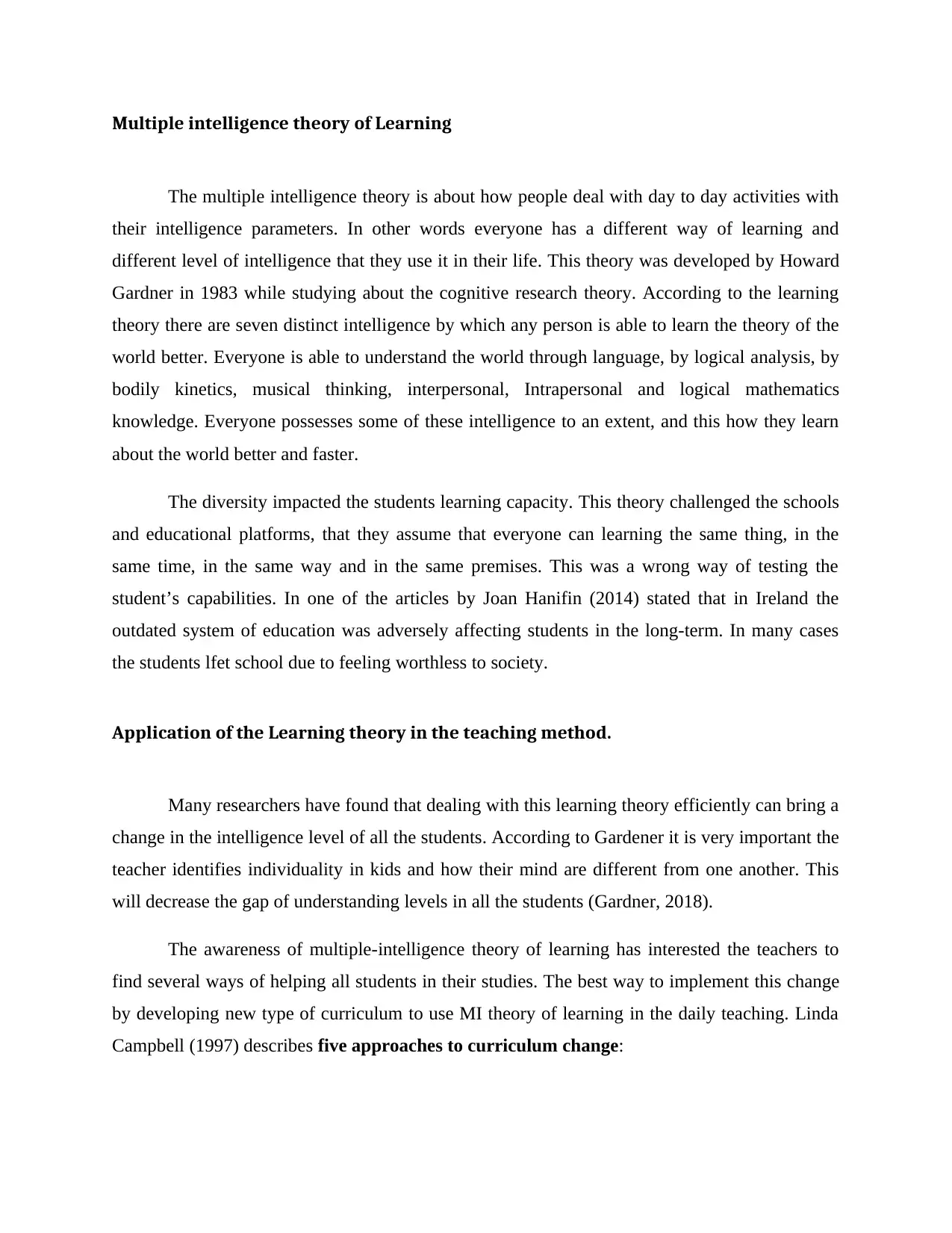
Multiple intelligence theory of Learning
The multiple intelligence theory is about how people deal with day to day activities with
their intelligence parameters. In other words everyone has a different way of learning and
different level of intelligence that they use it in their life. This theory was developed by Howard
Gardner in 1983 while studying about the cognitive research theory. According to the learning
theory there are seven distinct intelligence by which any person is able to learn the theory of the
world better. Everyone is able to understand the world through language, by logical analysis, by
bodily kinetics, musical thinking, interpersonal, Intrapersonal and logical mathematics
knowledge. Everyone possesses some of these intelligence to an extent, and this how they learn
about the world better and faster.
The diversity impacted the students learning capacity. This theory challenged the schools
and educational platforms, that they assume that everyone can learning the same thing, in the
same time, in the same way and in the same premises. This was a wrong way of testing the
student’s capabilities. In one of the articles by Joan Hanifin (2014) stated that in Ireland the
outdated system of education was adversely affecting students in the long-term. In many cases
the students lfet school due to feeling worthless to society.
Application of the Learning theory in the teaching method.
Many researchers have found that dealing with this learning theory efficiently can bring a
change in the intelligence level of all the students. According to Gardener it is very important the
teacher identifies individuality in kids and how their mind are different from one another. This
will decrease the gap of understanding levels in all the students (Gardner, 2018).
The awareness of multiple-intelligence theory of learning has interested the teachers to
find several ways of helping all students in their studies. The best way to implement this change
by developing new type of curriculum to use MI theory of learning in the daily teaching. Linda
Campbell (1997) describes five approaches to curriculum change:
The multiple intelligence theory is about how people deal with day to day activities with
their intelligence parameters. In other words everyone has a different way of learning and
different level of intelligence that they use it in their life. This theory was developed by Howard
Gardner in 1983 while studying about the cognitive research theory. According to the learning
theory there are seven distinct intelligence by which any person is able to learn the theory of the
world better. Everyone is able to understand the world through language, by logical analysis, by
bodily kinetics, musical thinking, interpersonal, Intrapersonal and logical mathematics
knowledge. Everyone possesses some of these intelligence to an extent, and this how they learn
about the world better and faster.
The diversity impacted the students learning capacity. This theory challenged the schools
and educational platforms, that they assume that everyone can learning the same thing, in the
same time, in the same way and in the same premises. This was a wrong way of testing the
student’s capabilities. In one of the articles by Joan Hanifin (2014) stated that in Ireland the
outdated system of education was adversely affecting students in the long-term. In many cases
the students lfet school due to feeling worthless to society.
Application of the Learning theory in the teaching method.
Many researchers have found that dealing with this learning theory efficiently can bring a
change in the intelligence level of all the students. According to Gardener it is very important the
teacher identifies individuality in kids and how their mind are different from one another. This
will decrease the gap of understanding levels in all the students (Gardner, 2018).
The awareness of multiple-intelligence theory of learning has interested the teachers to
find several ways of helping all students in their studies. The best way to implement this change
by developing new type of curriculum to use MI theory of learning in the daily teaching. Linda
Campbell (1997) describes five approaches to curriculum change:
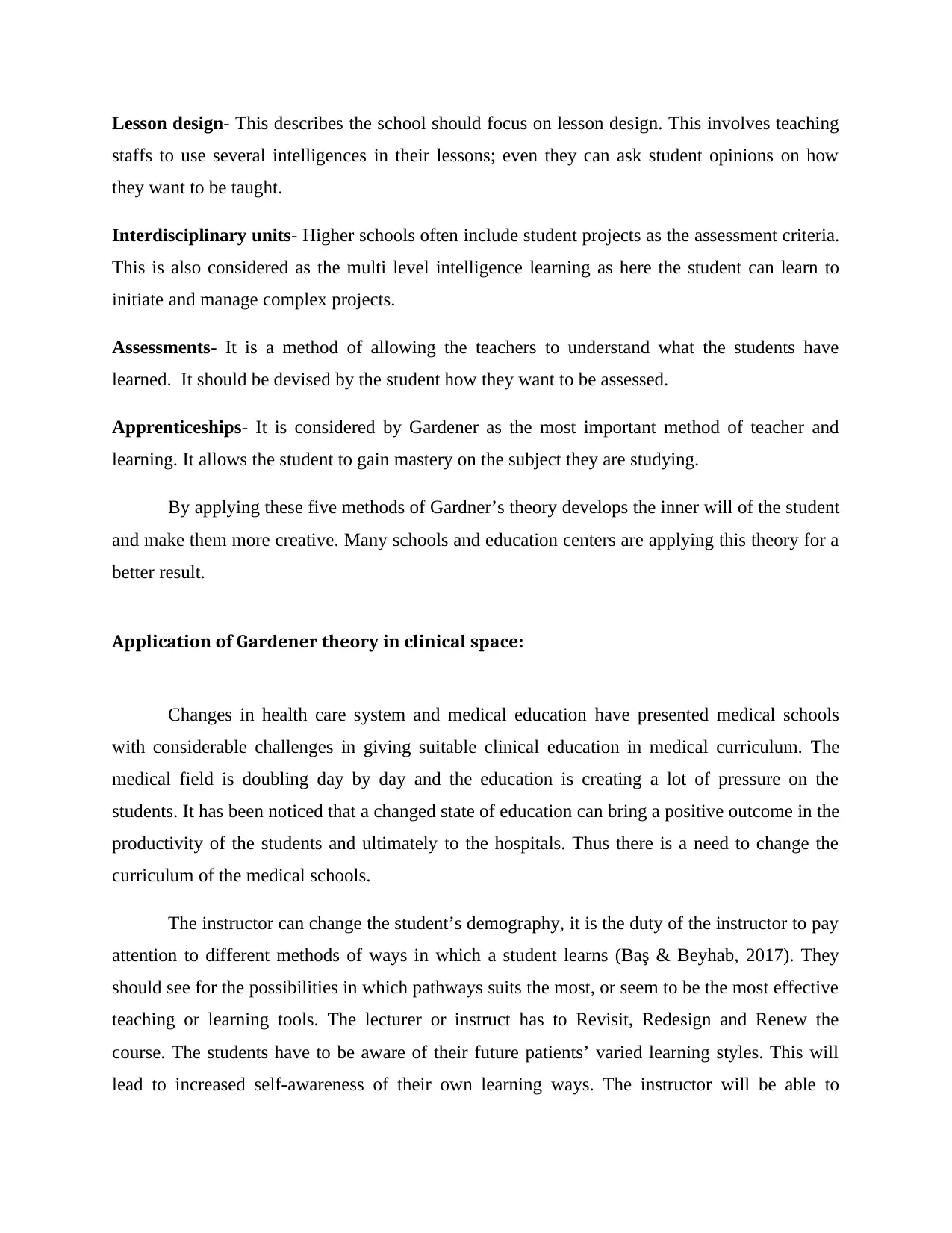
Lesson design- This describes the school should focus on lesson design. This involves teaching
staffs to use several intelligences in their lessons; even they can ask student opinions on how
they want to be taught.
Interdisciplinary units- Higher schools often include student projects as the assessment criteria.
This is also considered as the multi level intelligence learning as here the student can learn to
initiate and manage complex projects.
Assessments- It is a method of allowing the teachers to understand what the students have
learned. It should be devised by the student how they want to be assessed.
Apprenticeships- It is considered by Gardener as the most important method of teacher and
learning. It allows the student to gain mastery on the subject they are studying.
By applying these five methods of Gardner’s theory develops the inner will of the student
and make them more creative. Many schools and education centers are applying this theory for a
better result.
Application of Gardener theory in clinical space:
Changes in health care system and medical education have presented medical schools
with considerable challenges in giving suitable clinical education in medical curriculum. The
medical field is doubling day by day and the education is creating a lot of pressure on the
students. It has been noticed that a changed state of education can bring a positive outcome in the
productivity of the students and ultimately to the hospitals. Thus there is a need to change the
curriculum of the medical schools.
The instructor can change the student’s demography, it is the duty of the instructor to pay
attention to different methods of ways in which a student learns (Baş & Beyhab, 2017). They
should see for the possibilities in which pathways suits the most, or seem to be the most effective
teaching or learning tools. The lecturer or instruct has to Revisit, Redesign and Renew the
course. The students have to be aware of their future patients’ varied learning styles. This will
lead to increased self-awareness of their own learning ways. The instructor will be able to
staffs to use several intelligences in their lessons; even they can ask student opinions on how
they want to be taught.
Interdisciplinary units- Higher schools often include student projects as the assessment criteria.
This is also considered as the multi level intelligence learning as here the student can learn to
initiate and manage complex projects.
Assessments- It is a method of allowing the teachers to understand what the students have
learned. It should be devised by the student how they want to be assessed.
Apprenticeships- It is considered by Gardener as the most important method of teacher and
learning. It allows the student to gain mastery on the subject they are studying.
By applying these five methods of Gardner’s theory develops the inner will of the student
and make them more creative. Many schools and education centers are applying this theory for a
better result.
Application of Gardener theory in clinical space:
Changes in health care system and medical education have presented medical schools
with considerable challenges in giving suitable clinical education in medical curriculum. The
medical field is doubling day by day and the education is creating a lot of pressure on the
students. It has been noticed that a changed state of education can bring a positive outcome in the
productivity of the students and ultimately to the hospitals. Thus there is a need to change the
curriculum of the medical schools.
The instructor can change the student’s demography, it is the duty of the instructor to pay
attention to different methods of ways in which a student learns (Baş & Beyhab, 2017). They
should see for the possibilities in which pathways suits the most, or seem to be the most effective
teaching or learning tools. The lecturer or instruct has to Revisit, Redesign and Renew the
course. The students have to be aware of their future patients’ varied learning styles. This will
lead to increased self-awareness of their own learning ways. The instructor will be able to
⊘ This is a preview!⊘
Do you want full access?
Subscribe today to unlock all pages.

Trusted by 1+ million students worldwide
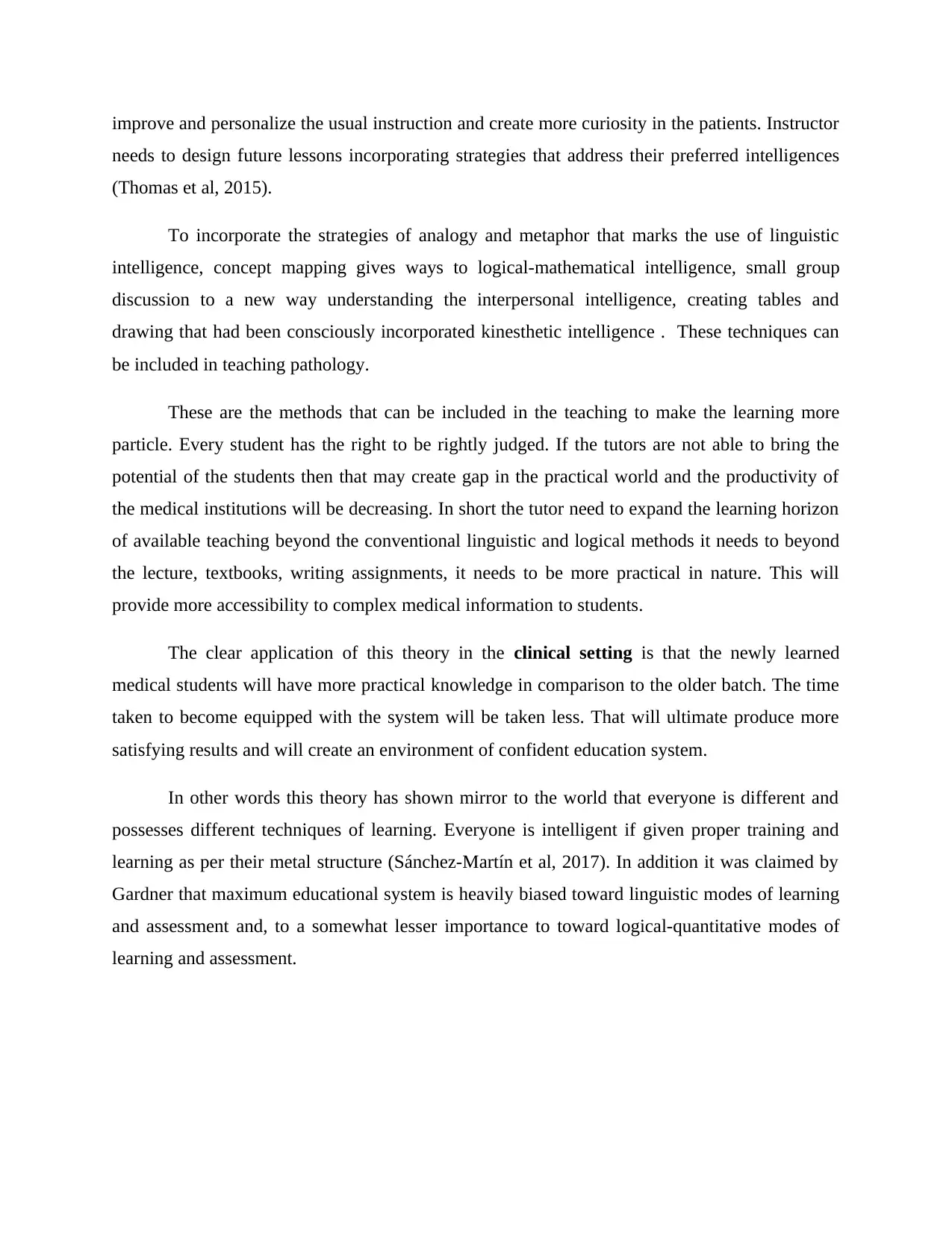
improve and personalize the usual instruction and create more curiosity in the patients. Instructor
needs to design future lessons incorporating strategies that address their preferred intelligences
(Thomas et al, 2015).
To incorporate the strategies of analogy and metaphor that marks the use of linguistic
intelligence, concept mapping gives ways to logical-mathematical intelligence, small group
discussion to a new way understanding the interpersonal intelligence, creating tables and
drawing that had been consciously incorporated kinesthetic intelligence . These techniques can
be included in teaching pathology.
These are the methods that can be included in the teaching to make the learning more
particle. Every student has the right to be rightly judged. If the tutors are not able to bring the
potential of the students then that may create gap in the practical world and the productivity of
the medical institutions will be decreasing. In short the tutor need to expand the learning horizon
of available teaching beyond the conventional linguistic and logical methods it needs to beyond
the lecture, textbooks, writing assignments, it needs to be more practical in nature. This will
provide more accessibility to complex medical information to students.
The clear application of this theory in the clinical setting is that the newly learned
medical students will have more practical knowledge in comparison to the older batch. The time
taken to become equipped with the system will be taken less. That will ultimate produce more
satisfying results and will create an environment of confident education system.
In other words this theory has shown mirror to the world that everyone is different and
possesses different techniques of learning. Everyone is intelligent if given proper training and
learning as per their metal structure (Sánchez-Martín et al, 2017). In addition it was claimed by
Gardner that maximum educational system is heavily biased toward linguistic modes of learning
and assessment and, to a somewhat lesser importance to toward logical-quantitative modes of
learning and assessment.
needs to design future lessons incorporating strategies that address their preferred intelligences
(Thomas et al, 2015).
To incorporate the strategies of analogy and metaphor that marks the use of linguistic
intelligence, concept mapping gives ways to logical-mathematical intelligence, small group
discussion to a new way understanding the interpersonal intelligence, creating tables and
drawing that had been consciously incorporated kinesthetic intelligence . These techniques can
be included in teaching pathology.
These are the methods that can be included in the teaching to make the learning more
particle. Every student has the right to be rightly judged. If the tutors are not able to bring the
potential of the students then that may create gap in the practical world and the productivity of
the medical institutions will be decreasing. In short the tutor need to expand the learning horizon
of available teaching beyond the conventional linguistic and logical methods it needs to beyond
the lecture, textbooks, writing assignments, it needs to be more practical in nature. This will
provide more accessibility to complex medical information to students.
The clear application of this theory in the clinical setting is that the newly learned
medical students will have more practical knowledge in comparison to the older batch. The time
taken to become equipped with the system will be taken less. That will ultimate produce more
satisfying results and will create an environment of confident education system.
In other words this theory has shown mirror to the world that everyone is different and
possesses different techniques of learning. Everyone is intelligent if given proper training and
learning as per their metal structure (Sánchez-Martín et al, 2017). In addition it was claimed by
Gardner that maximum educational system is heavily biased toward linguistic modes of learning
and assessment and, to a somewhat lesser importance to toward logical-quantitative modes of
learning and assessment.
Paraphrase This Document
Need a fresh take? Get an instant paraphrase of this document with our AI Paraphraser
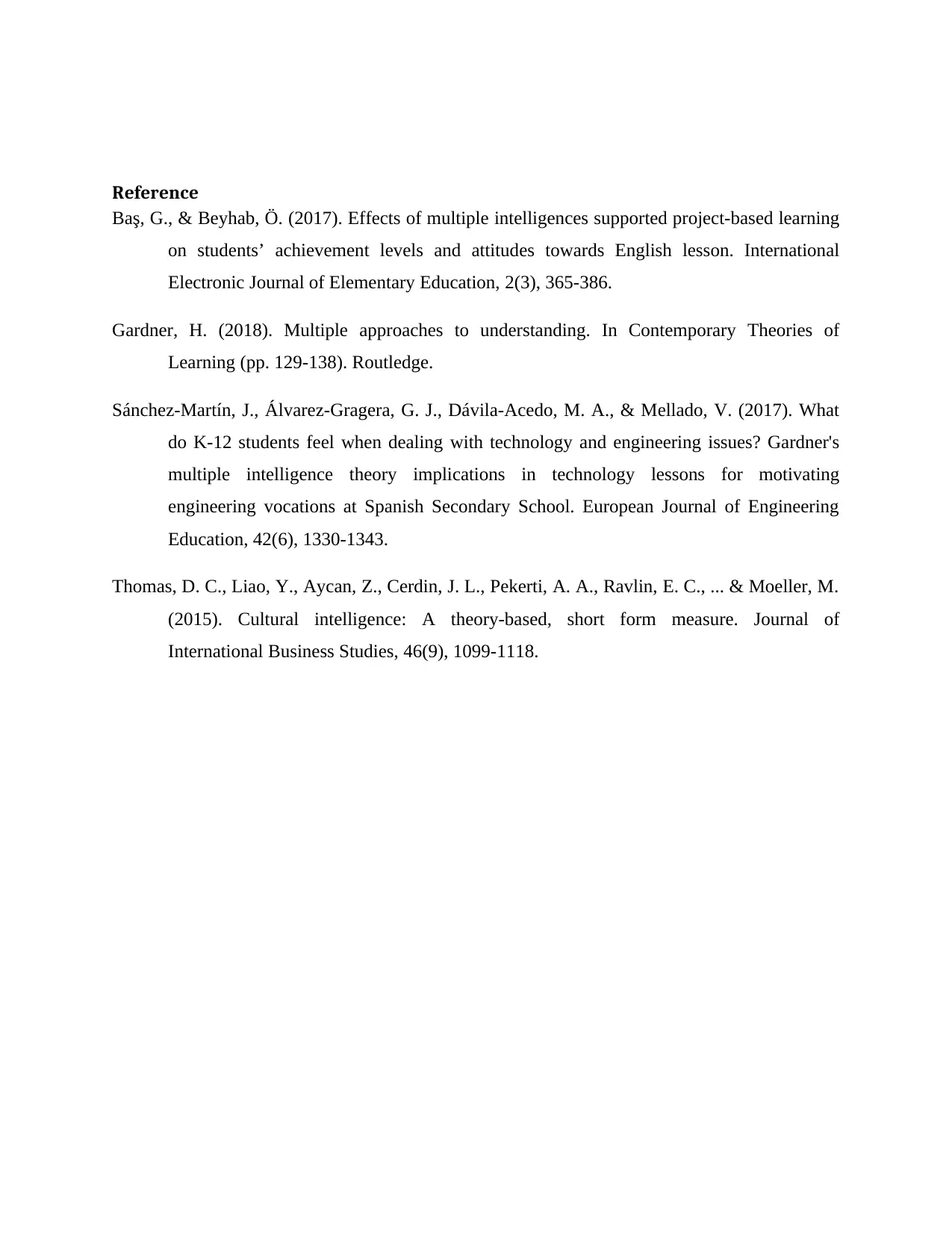
Reference
Baş, G., & Beyhab, Ö. (2017). Effects of multiple intelligences supported project-based learning
on students’ achievement levels and attitudes towards English lesson. International
Electronic Journal of Elementary Education, 2(3), 365-386.
Gardner, H. (2018). Multiple approaches to understanding. In Contemporary Theories of
Learning (pp. 129-138). Routledge.
Sánchez-Martín, J., Álvarez-Gragera, G. J., Dávila-Acedo, M. A., & Mellado, V. (2017). What
do K-12 students feel when dealing with technology and engineering issues? Gardner's
multiple intelligence theory implications in technology lessons for motivating
engineering vocations at Spanish Secondary School. European Journal of Engineering
Education, 42(6), 1330-1343.
Thomas, D. C., Liao, Y., Aycan, Z., Cerdin, J. L., Pekerti, A. A., Ravlin, E. C., ... & Moeller, M.
(2015). Cultural intelligence: A theory-based, short form measure. Journal of
International Business Studies, 46(9), 1099-1118.
Baş, G., & Beyhab, Ö. (2017). Effects of multiple intelligences supported project-based learning
on students’ achievement levels and attitudes towards English lesson. International
Electronic Journal of Elementary Education, 2(3), 365-386.
Gardner, H. (2018). Multiple approaches to understanding. In Contemporary Theories of
Learning (pp. 129-138). Routledge.
Sánchez-Martín, J., Álvarez-Gragera, G. J., Dávila-Acedo, M. A., & Mellado, V. (2017). What
do K-12 students feel when dealing with technology and engineering issues? Gardner's
multiple intelligence theory implications in technology lessons for motivating
engineering vocations at Spanish Secondary School. European Journal of Engineering
Education, 42(6), 1330-1343.
Thomas, D. C., Liao, Y., Aycan, Z., Cerdin, J. L., Pekerti, A. A., Ravlin, E. C., ... & Moeller, M.
(2015). Cultural intelligence: A theory-based, short form measure. Journal of
International Business Studies, 46(9), 1099-1118.
1 out of 5
Related Documents
Your All-in-One AI-Powered Toolkit for Academic Success.
+13062052269
info@desklib.com
Available 24*7 on WhatsApp / Email
![[object Object]](/_next/static/media/star-bottom.7253800d.svg)
Unlock your academic potential
Copyright © 2020–2025 A2Z Services. All Rights Reserved. Developed and managed by ZUCOL.



